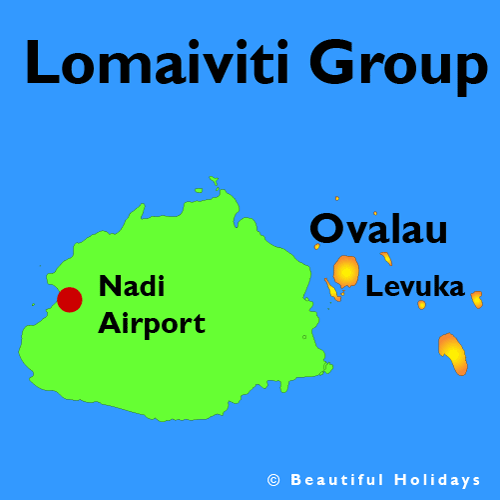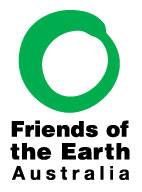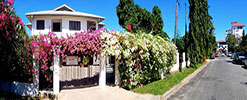Travel Guide to Lomaiviti, Lau & Rotuma, Fiji Islands

Ovalau Island & Levuka Town — Small Islands off Ovalau — Koro & Gau — Rotuma Island
Travel Off the Beaten Track
Small Uninhabited Islands
Rich in History & Legends
Excellent Scuba Diving & Snorkelling
Explore Fijian Villages
What is surprising is that the Lomaiviti Group is the least visited region in Fiji by tourists even though it is relatively easy to reach by both plane and boat. Go back in time a hundred years or so and these were the busiest and historically most important islands in Fiji. Ovalau is home to the old capital of Fiji, the heritage town of Levuka and the surrounding islands are rich in history, especially with the arrival of European whalers and traders in what became Fiji's explosive colonial era. There are several islands in this group supporting large Fijian village communities, especially on Gau and Koro, both of which have an airstrip albeit rudimentary. Beyond is the Lau Group, a scattering of gorgeous small islands popular with sailors, whilst the Polynesian island of Rotuma lies in the very northern region of Fiji, 2 days by cargo boat from Suva and receives virtually no tourists.
Lomaiviti Holidays Overview
Ovalau Island & Levuka Town

Ovalau Island is a mountainous tropical island with a central crater and boasting historical Levuka Town, the old capital of Fiji which attracts most visitors to the island. It's a sleepy town with plenty of history and is a great place to meet the locals and hear their tales about Fiji's colourful past when tribal warfare, cannibalism, whaling and drunken European traders plagued the region.
... more about Levuka Town & Ovalau
Small Islands around Ovalau
The coastline around Ovalau is quite rugged and mostly without beaches, dotted here and there with small villages. The drier coastline of North Ovalau has rolling grassy hills overlooking the island of Naigani with a small resort and several large hill forts. Off the south coast are a handful of beautiful small islands including the revitalised backpacker resorts of Caqalai and Leleuvia, both on tiny coral islands.
Naigani Island and Wakaya Island to the north and east of Ovalau are both fascinating islands for exploring and have rough roads across the island for easy access. Both islands have resorts with private golf courses. Wakaya Club is one of the most exclusive in the country.
There are several small coral islands to the south-east of Ovalau not that far from Suva that have accommodation. Toberua island has a charming small resort and although it is in the upper price range it has an unpretentious atmosphere and offers village tours, visits to uninhabited Mabualau Island (home of thousands of nesting red-footed boobies birds) and mangrove river trips as well as the luxury of golf at low tide. Caqalai has the most basic accommodation in the group with simple thatch bures and communal cold showers from a bucket. Provisions can be sparse. The beach is good and you really get the feeling of being away from it all although the island can be suffocating as it only takes fifteen minutes to walk around. Nearby Leluvia is a little larger and a more commercialised backpacker hangout with PADI diving and some organised activities.
Toberua Island
Accessed from Nakelo Landing along the Qaraniki River, lined with mangroves and bamboo fish traps, and three kilometres into the ocean beyond Kaba Point, is the sandy coral cay of Toberua Island. Boasting one of Fiji’s original boutique resorts, Toberua Island Resort is an incredibly friendly home where staff have lived and worked for thirty years and life-long guests return time and again, some clocking up as many as thirty visits. There are fantastic colourful coral formations and reef sharks at Toberua Passage which are excellent for both snorkelling and scuba diving. Mabualau, a limestone islet five kilometres to the east, is a tiny nature reserve inundated with large white fluffy Boobies.
Thirty minutes by boat from Levuka, and about the same distance to mainland Viti Levu, are two small backpacker resorts on tiny uninhabited coral islands. Caqalai Island Resort has ten bures on the edge of the beachfront. It takes fifteen minutes to walk around the white sandy beach which surrounds this tiny coral island, and you can wade out to Snake Island at low tide with good snorkelling and the chance to spot the black and white poisonous sea snakes. Even better snorkelling is at Honeymoon Island, a sand spit five kilometres to the east where you’ll likely spot small grey tip reef sharks hiding amongst the coral reefs. The other option is Leleuvia Island Resort, a similar small coral island with sandy beach and surrounded by a fringing reef.
The larger islands of Gau and Koro in the east have excellent exploring potential although accommodation is limited (Gau has an expensive artists retreat). The plus for these islands is that although they have no tourism, they are easy to get to with several flights each week and both islands have roads and local transport connecting the islands' many local villages. For those who really want to explore, Koro and Gau are ideal - you will not run into other tourists and the local people are friendly and very helpful. Plan ahead to make accommodation arrangements.
Bau Island
Seven kilometres north of Kaba Point is the chiefly island of Bau. To visit the tiny island, accessible by punt from Bau Landing, you should contact the Turaga-ni-Koro on Bau Island. If you do manage to receive an invitation, take yaqona roots and dress respectably. The island is small in size, but with a fascinating history. The mound in the centre of the island is where the chiefly families live, and around the parameter are sub clans: craftsmen from Lau warriors from Botoni and fishermen from Kadavu. Here stands the first church in Fiji, built from thick limestone walls. The baptismal font beside the alter was Cakobau’s killing stone where skulls of his captives were smashed before being eaten.
Koro & Gau
Seventy kilometres north east of Ovalau and less than fifty kilometres south of Vanua Levu is the triangular shaped island of Koro. Rising to a peak of 560 metres, this volcanic island has splendid views from its inland road with bush tracks and waterfalls amongst its tropical forests. The largest village is Nasau, mid way along the east coast about five kilometres north of the airstrip and has a hospital, post office, a cooperative store and government headquarters. The women of Koro are renowned for their finely woven handicrafts, particularly mats and fans. There is currently no accommodation on Koro so the only way to visit is by receiving an invite from a local family.
The substantial 140 square kilometre island of Gau lies sixty kilometres south of Koro and is characterized by dense rainforest on its high ridges, grasslands in the lower hills, sandy beaches along the south coast and mangroves in the north from where the islands of Nairai and Batiki can be seen. The largest village is Qarani, home to internationally acclaimed rugby superstar Waisale Serevi, with the safest anchorage for yachts and the island’s only doctor. The road around Gau has long been overgrown and dysfunctional so travel between villages is by small boat or bush track.
Lomaiviti Travel Info
Daily flights to Ovalau depart daily from Nadi taking about 40-minutes, or its a 15-minute hop from Nausori Airport. Open top fibreglass boats shuttle locals back and forth between Viti Levu and most islands with most boats departing from wither Waidalice Landing or Natovi Landing (both north of Nausori) or from Nausori Town itself. A large passenger ferry departs most days from Natovi Landing to Ovalau and takes about 60-minutes.
Rotuma - The Polynesian Island of Fiji

Rotuma Island lies to the far north of Fiji, some 500km from Nadi. The Polynesian island has its own unique culture, language and history. The island is blessed with beautiful scenery, gorgeous beaches and some interesting archaeological sites including the huge kine'he'he platform and the grave of the kings at Sisilo. The island has walking tracks meandering throughout the interior and a sand coastal road that takes a full day to circumnavigate. Villages are spread out along the road, divided into seven districts. Tourism on Rotuma is virtually non-existent and there are no hotels here and infrequent flights. The cargo boat from Suva takes 2 days and 2 nights and currently there is no accommodation for tourists.
Where do you want to go now ?
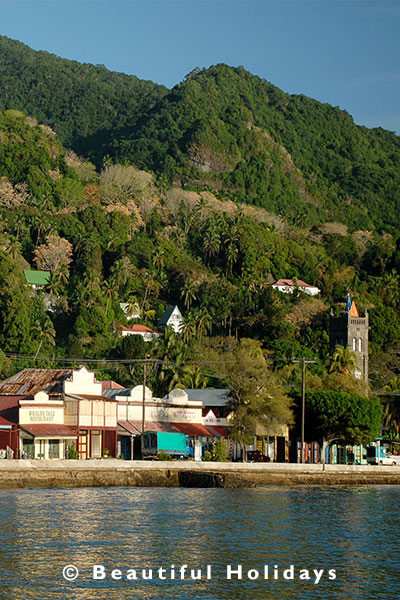 view of levuka town
view of levuka town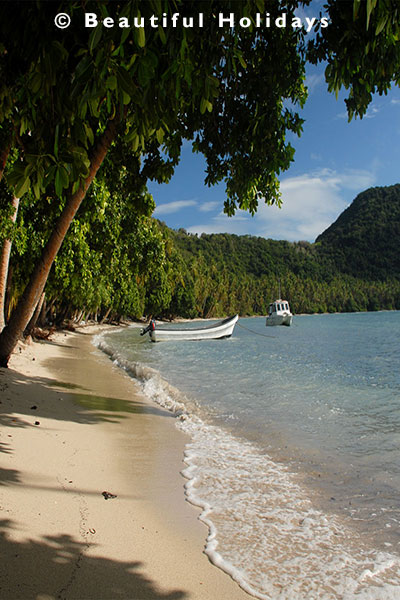 beach at naigani island
beach at naigani island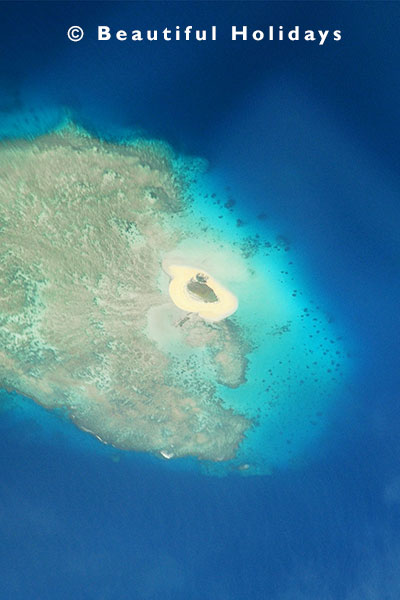 uninhabited island
uninhabited island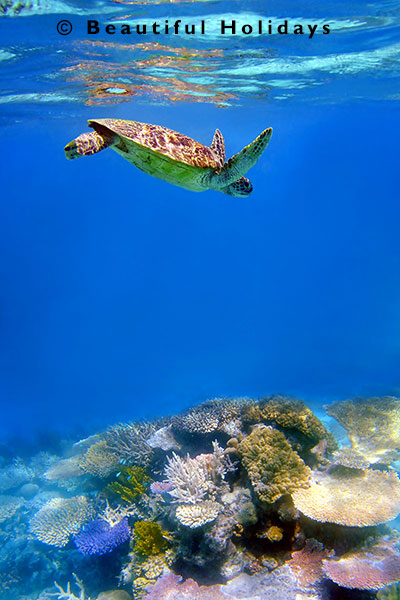 sea turtle and coral reef
sea turtle and coral reef